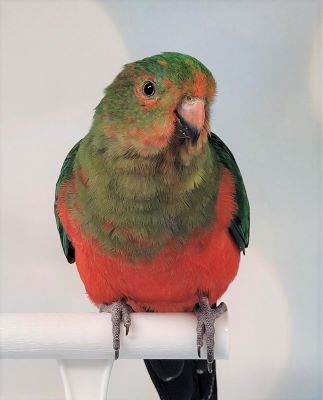
It’s the last day of April, which means it’s our last day with our April Animal of the Month – the Australian king parrot. We hope you followed along with us on Twitter @ExoticPetVets as we tweeted all month long about these colourful characters. If you missed any of our tweets, here is a summary that you can refer to at any time. Did you know?:
- Their name betrays where Australian king parrots (Alisterus scapularis) are from originally. They are endemic to Australia, of course!
- One could assume that Australian king parrots are commonly found all over Australia – given their name – but this is not the case. The Australian king parrot is mostly found along Australia’s eastern coast.
- Australian king parrots are considered to be sedentary birds because they do not seasonally migrate over long distances.
- In the wild, a common Australian king parrot habitat is the humid rainforest. They are also found in wet sclerophyll forests, which consist of very tall eucalypts that make up the canopy, with smaller trees and shrubs growing underneath.
- Australian king parrots can also be found in suburban and urban areas – as long as there are a lot of trees around.
- It’s not often that you will see wild Australian king parrots flying high above the tree tops. They prefer to fly beneath the tree canopy, weaving among the tree trunks.
- Australian king parrots are large parrots and typically measure between 40-43 cms (15.7 – 17 inches) in length, including their long tails.
- While there is no size differential between fully-grown male and female Australian king parrots, they look completely different so they are considered to be a sexually dimorphic species.
- The male Australian king parrot has a brilliant red head, breast and belly. His wings and back and tail are green. He also has a pale bluish-green band on each wing.
- The male Australian king parrot also has a dark blue band on the back of his neck and his rump is also dark blue. His long broad tail is a very dark green. The upper part of his beak is reddish-orange with a black tip, while the lower part of his beak is black.
- The female Australian king parrot looks very different from her male counterpart. Her head and breast are green instead of red. She also doesn’t have the pale bluish-green band on her wings and her beak is grey.
- Juvenile Australian king parrots have colouring that is similar to adult females.
- To the naked human eye, Australian king parrots are predominantly red and green. But when viewed under ultraviolet light, we can see that some of their feathers have a distinct yellow glow.
- Like many birds, Australian king parrots have four types of cone in their eyes (unlike humans who only have three) so they can see ultraviolet light wavelengths.
- Some sources suggest this ability to see UV light wavelengths helps Australian king parrots find food when they are feasting on flowers. It is also suggested this visual ability may aid their navigation on cloudy days.
- Australian king parrots in the wild will mainly forage for food up in the trees. They eat seeds, flowers, nuts and fruits. They will also eat from avian feeding stations set up in suburban areas.
- Large parrots are often associated with having big voices. But this is not the case for Australian king parrots. Even though they are among the larger parrot species, they are relatively quiet compared to many other large avian species.
- But when Australian king parrots do vocalize, they chatter and they also have a loud high-pitched call which some describe as sounding like a squeaky metal door or gate.
- Australian king parrots are capable of mimicking human speech, but they are not known for being able to speak with the same level of proficiency and clarity as other species of parrots.
- Australian king parrots are a long-lived parrot species. With proper care in captivity, they can live between 25-30 years on average.
- It is unclear if Australian king parrots live that long in the wild. According to the Parrot Society of New Zealand, it’s believed wild Australian king parrots have an average lifespan of about 15 years.

